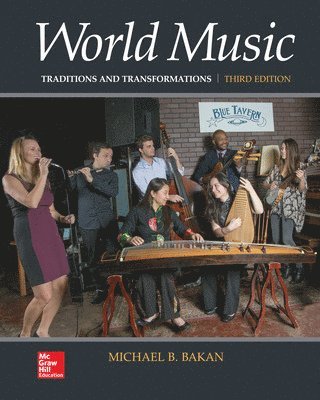
- Format
- Häftad (Paperback)
- Språk
- Engelska
- Utgivningsdatum
- 2018-09-06
- Upplaga
- 3
- Förlag
- McGraw Hill
- Illustrationer
- Illustrations, unspecified
- Dimensioner
- 262 x 208 x 20 mm
- Vikt
- Antal komponenter
- 1
- ISBN
- 9780078025198
- 920 g
World Music: Traditions and Transformations
Slutsåld
Kundrecensioner
Fler böcker av Michael Bakan
-
Music and Autism
Michael Bakan, ), Graeme Gibson, Elizabeth J Grace, Zena Hamelson
The musical talents and affinities of autistic people are widely recognized, but few have thought to ask autistic people themselves about how they make and experience music, and why it matters them that they do. Speaking for Ourselves does just th...
Övrig information
Michael B. Bakan is Professor of Ethnomusicology and Head of Ethnomusicology/World Music in the College of Music at Florida State University, where he also directs the universitys Balinese gamelan ensemble and the Music-Play Project, a program for children on the autism spectrum and their families. He has been the recipient of numerous awards and honors, including two Florida State University Undergraduate Teaching Awards (1998, 2010). His first book, Music of Death and New Creation: Experiences in the World of Balinese Gamelan Beleganjur (University of Chicago Press, 1999), was selected to the Choice Outstanding Academic Titles list for the year 2000 and was recognized as one of the two most significant publications on Balinese music in almost half a century in The Times (London). The first edition of World Music: Traditions and Transformations (McGraw-Hill, 2007) has been adopted at more than 100 universities and colleges worldwide. Bakans many other publications encompass topics ranging from Indonesian music and world percussion to electronic music technology, early jazz history, film music, multicultural music education, and the ethnomusicology of autism. He is also the series editor of the Routledge Focus on World Music Series. As a percussionist, Bakan has performed with many renowned world music, jazz, and Western classical music artists and ensembles, including the Toronto Symphony Orchestra, the Music at Marlboro Festival Orchestra, John Cage, A. J. Racy, Phil Nimmons, I Ketut Sukarata, and the championship beleganjur groups of Batur Tengah and Tatasan Kaja in Bali, Indonesia. He is also an active composer, with traditional and experimental works for Balinese gamelan, world music/jazz fusion pieces, film scores, and modern dance compositions to his credit. Bakan has been a visiting professor or invited lecturer at numerous institutions, including Harvard, Yale, Indiana, and Boston universities; the universities of Chicago, Colorado, Illinois, Maryland, and Washington; and the Berklee College of Music. He previously served as president of the Society for Ethnomusicologys Southeast/Caribbean Chapter. He and his family live in Tallahassee, Florida.
Innehållsförteckning
world music: traditions and transformations, 3e
Part 1
CHAPTER 1: What, in the World, Is Music?
CHAPTER2: How Music Lives: A Musicultural Approach
CHAPTER 3: How Music Works: Part I: Rhythm
CHAPTER 4: How Music Works: Part II: Pitch
CHAPTER 5: How Music Works: Part III: Dynamics, Timbre, and Instruments
CHAPTER 6: How Music Works: Part IV: Texture and Form
Part 2
CHAPTER 7: Indonesian Gamelan Music: Interlocking Rhythms, Interlocking Worlds
CHAPTER 8: From Raga to Bollywood: Developments and Intercultural Crossings in Indian Music
CHAPTER 9: 'Not the Same, but Just as Nice': Traditions and Transformations in Irish Music
CHAPTER 10: The River and the Path: Conversation and Collective Expression in West African Musics
CHAPTER 11: 'Listen How It Goes': "Oye Como Va" and the Musics of Latin America
CHAPTER 12: From Baladi to Belly Dance: Rhythm, Dance, and Music in Egypt and Beyond
CHAPTER 13: A Musicultural History of the Chinese Zheng
Du kanske gillar
-
Real Book
Häftad -
The Creative Act
Rick Rubin
Inbunden
